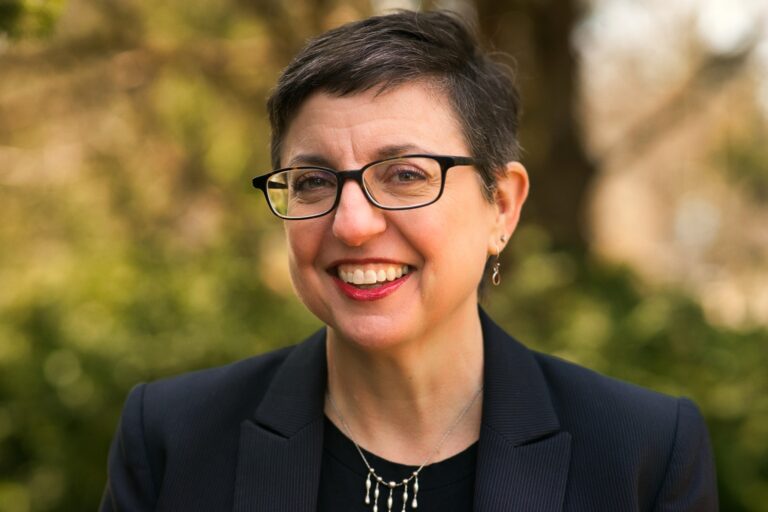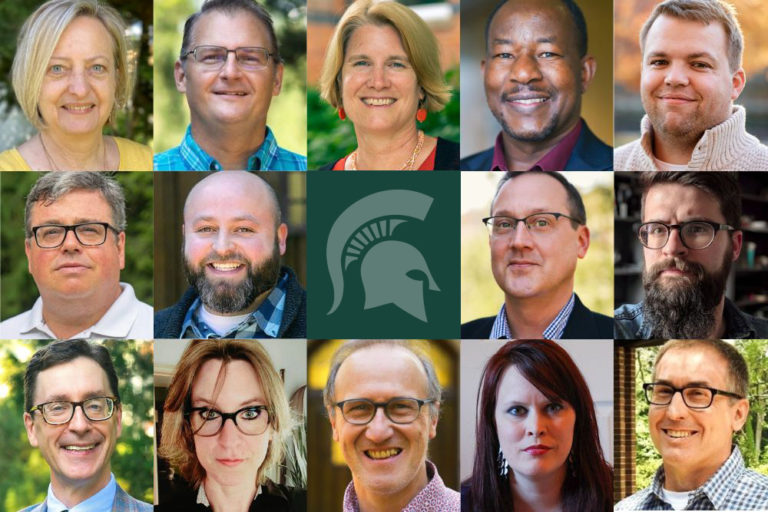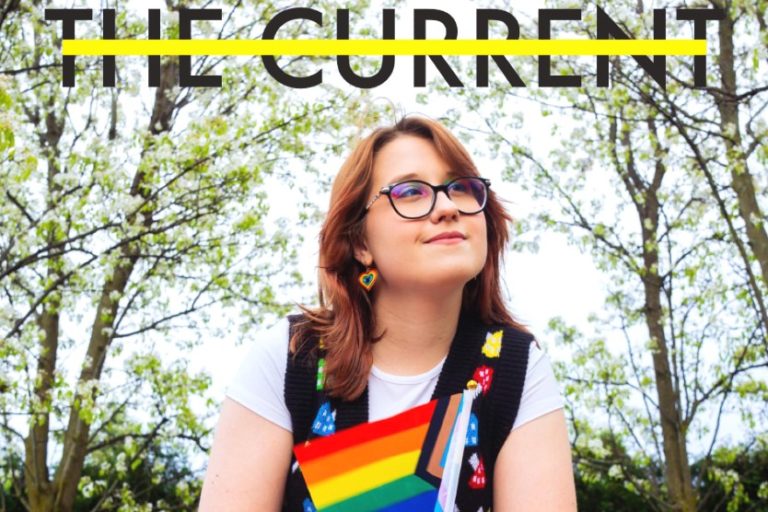Before enrolling in a writing course at MSU, undergraduates might view writing as a solitary act: performed alone by a creative professional, or as a one-way conversation between an author and invisible readers. But across the Department of Writing, Rhetoric, and Cultures (WRAC), faculty invite their students to challenge these traditional notions.
In both graduate and undergraduate settings, WRAC courses push beyond one-dimensional conceptions of writing in favor of collaboration and community-building. Whether they’re pursuing a Minor in Writing (MiW), a Professional and Public Writing (P2W) degree, or simply fulfilling a writing requirement, students from all majors have the opportunity to develop their definitions of writing and apply them to their professional aspirations.
In the spirit of collaboration, Assistant Professors Dr. Margaret Morris and Dr. Bree Straayer teamed up with Ethan Voss and Mary Murdock, both graduate students in the Master of Arts (MA) in Rhetoric and Writing program, to teach two P2W courses this spring semester:
- Writing in Corporate Contexts (WRA 333), taught by Dr. Morris and Voss
- Writing in the Public Interest (WRA 331), taught by Dr. Straayer and Murdock
These graduate-faculty partnerships enrich the experiences of undergraduates and the learning outcomes of all involved.
WRA 333: Writing in Corporate Contexts
In WRA 333, Dr. Morris and Voss invite students to read, analyze, and produce the kinds of writing that function as “glue” in corporate communications: from public-facing messages and crisis response to business emails and even group chats.
Through a series of four projects, students reflect on prior experiences and apply their unique knowledge sets to their future roles, professional contexts, and responsibilities. Together, Dr. Morris and Voss engage students in a mixture of audience analysis, writing production, and presentations, with a continual emphasis on professionalism and corporate leadership.
Dr. Morris frames conversations about corporate work with Dare to Lead, written by researcher, professor, and storyteller Brené Brown. After reading Brown’s book, students are asked to present core concepts from the text and articulate their strengths and opportunities for leadership development. Through this work, “students begin to take on their own markers of leadership, and hopefully begin to understand that leadership – and writing – isn’t about being perfect, but rather vulnerable and self-correcting,” Dr. Morris said.

These aims are reinforced by the students’ final two projects, which ask them to create plans for success as future leaders and writers in corporate environments. Each student reflects on the course in a letter, in which they articulate their intentions as young writers entering a fast-changing workforce.
A Partnership Built on Past Experiences
Dr. Morris brings real-world corporate experience and over twenty years of teaching experience to her classroom. This is her second time teaching WRA 333 as well as collaborating with Voss; last fall, the duo co-taught WRA 370, an introductory course in grammar and editing.
As an undergraduate at the University of Minnesota, Voss’ two favorite courses were “Technical and Professional Writing” and “Editing, Critique, and Style.” In addition to sharing relevant knowledge from his undergraduate years, Voss offers his perspectives as a young adult and current student to connect with undergraduates in WRA 331, many of whom are seniors.

“I was in their position not too long ago, so I’m often asking: ‘How can we prepare these students to launch into the next phase of life?’” Voss said.
As a former writer in a corporate setting, Dr. Morris also understands the particular nature of corporate environments that many of her students will enter after graduating this spring.
“When students get to the workplace, they’re going to be writing a lot,” Dr. Morris said. “In a corporate setting, you have to be in good relationships with people across the organization, so you can gather the information you need and write it up in a way that meets the needs and expectations of your audience.”
In anticipation of these demands, Dr. Morris and Voss ask their students to write across different modes of writing while attending closely to their audiences, which involves analysis and research to better understand the needs of hypothetical readers. In the classroom, peers function as readers and supporters, so Dr. Morris and Voss strive to foster a communal space where students feel comfortable sharing, brainstorming, and writing together.

“One of my primary aims as a P2W Professor is to create a small community in every classroom where people really know each other, their strengths and weaknesses, and trust in the process of sharing their writing,” Dr. Morris said.
Intentional community-building is especially vital in classrooms with varied academic interests. In WRA 333 alone, represented majors include Neuroscience, Textile and Apparel, Japanese, Communications, Political Science and Theory, and Experience Architecture. Students often enroll in P2W courses like WRA 333 to fulfill requirements for the MiW or complete a writing elective, so P2W faculty – and teaching assistants like Voss – work with students from diverse backgrounds.
By getting to know these students “on a more granular level,” Dr. Morris said, she can tailor their activities and teams to align with their educational goals and personal needs. “Every class, we check in and try to be honest with each other. We share a lot of laughter, and then we forge forward.”
Co-Teaching = Co-Learning
Collaborating with Voss – who will complete his MA in Rhetoric and Writing this spring and begin a Ph.D. program next fall – “lets me perceive new ways to come into the classroom and infuse it with life and knowledge,” Dr. Morris reflected. She attributes the success of their collaboration to shared pedagogical values, enthusiasm, and overall “synergy.”
“Ethan and I have complementary values of building community, listening to students, and centering students in our pedagogy,” Dr. Morris described. She contends that the students in WRA 333 also benefit from their collaboration, as they get to work with both a long-time professor and former corporate professional and a younger educator with newer theory and praxis.
Both Dr. Morris and Voss bring their enthusiasm for relationship-building via writing, as well as their shared belief in the value of pedagogical partnerships in higher education. “In teaching settings, there’s so much value in observation, but even more in the process of actively engaging your ideas and putting them into practice,” Dr. Morris said. “Most of the time, students are so eager to learn that they’re forgiving about your learning process as a teacher.” It can take years to develop one’s “teacherly identity,” Dr. Morris noted – and she’s still doing it alongside Voss.
Preparing Students for Future Work – and Future Writing
The impending job search can feel daunting for many students, so Voss and Dr. Morris take measures to ground their class in the present moment with supportive check-ins and a “Dumb Question of the Day” – usually supplied by Voss – that imbue the classroom with honesty and a therapeutic dose of humor.
These pedagogical moves support the professional and personal success of undergraduates, as well as Voss’ personal journey as a graduate student. After completing his Ph.D., Voss sees himself teaching in a First-Year Writing Program and eventually working as a Director. From there, he plans to eventually transition into other leadership roles, but always circling back to his original love for higher education, classroom community, and the students who define this work.
In this specific course and across his pedagogy, Voss views the classroom as a space to gather and “foster the development of genuinely good people: ones who can leave as leaders and understand the importance of engaging with other people, exactly as they are.”
“Regardless of whether they go into a corporate setting or somewhere else, we want students to make genuine changes in the spaces they enter,” Voss said.
Voss and Dr. Morris recently submitted a presentation proposal to talk about their co-teaching experience at the Spring 2024 Teaching and Learning Conference, hosted by the Center for Teaching and Learning Innovation. They look forward to completing the semester together and sharing about their collaboration with a larger community of teachers, researchers, and writers.
WRA 331: Writing in the Public Interest
Across the hall, Murdock and Dr. Straayer teach undergraduates about nonprofit writing in WRA 331. While acknowledging their roles as teachers first, they also wear “the hats of clients, such that students are creating deliverables that would be used in a nonprofit communications strategy or a real community,” Murdock reflected.

Dr. Straayer offered a similar sentiment. “As a class, we’re really invested in understanding what reading and writing look like in community spaces, and not just in higher education.”
In keeping with this community-centric vision, Dr. Straayer and Murdock incorporate a mixture of projects and learning modalities into WRA 331. Across assignments, they emphasize hands-on creation and thinking about the complexities of writing for nonprofit organizations, especially compared to corporate settings.
The course is structured around five assignments, beginning with an introductory project that asks students to analyze and adjust an example of nonprofit communication with significant room for improvement. Students get a chance to play with design in a low-stakes environment, familiarize themselves with writing in the nonprofit sphere, and “make constructive changes and see what challenges arise in the process,” Dr. Straayer described. Students find that while “it’s easy to critique a writing sample, it’s much harder to make it ‘right,’” she said.
This foundational assignment prepares students for the remaining four projects, which collectively ask them to consider the role of audience, storytelling, and personal values when communicating on behalf of a nonprofit organization. The course simulates the challenges and affordances of writing for nonprofits, whether on a freelance or in-house basis: through case studies, rhetorical analysis of common documents, project management, and ongoing reflection.

In the students’ third project, which explores the role of storytelling in the nonprofit world, Dr. Straayer asks students to consider the ethics of communicating other people’s stories. “We consider what it looks like to give others agency in the composition practice – because in the nonprofit world, so much of writing is storytelling,” Dr. Straayer said. In this specific project but also throughout the course, Dr. Straayer and Murdock focus on preparing students to enter a nonprofit setting with care and intention.
“We want to prepare students to listen and understand their own positionality and lens through which they view the world, so when they’re working with communities, they understand how to work with a certain kind of sensitivity and thinking,” Dr. Straayer described. “When we tell stories in nonprofit spaces, we want to honor the people we’re working with and show them in the fullness of who they really are, and ensure that we’re not just shedding one light.”
Replicating Community Work in the Writing Classroom
Prior to teaching in WRAC, Dr. Straayer worked for three years at the Literacy Center of West Michigan and oversaw their program for parents learning English. As a graduate student at MSU, Dr. Straayer worked with English Language Learners at Bethany Christian Services; and during the summers, she taught at Grand Rapids Community College as an English Fast Track Instructor. These highly immersive experiences – centered around one-on-one relationships – continue to inform Dr. Straayer’s teaching philosophy in WRA 331.
Dr. Straayer also has ample experience mentoring younger professionals like Murdock, who originally got involved in WRA 331 to fulfill the internship requirement for her MA concentration in Professional Writing and Technical Communication. On a more personal level, Murdock views this internship as an opportunity to expand the definition of teaching, particularly as it relates to her professional interests in nonprofit work.
“Teaching happens everywhere,” Murdock said. “Even though I’m not currently interested in classroom teaching as a career, I find that teaching happens across professional spaces and roles: in nonprofit leadership, project management, even user experience and design work.”
Murdock incorporates various pedagogical tools and experiences from her work in the Cube – a publishing and user experience research center in WRAC – to give undergraduates in WRA 331 an experience she called “workplace-light.”
“When you’re presenting something to a client, explaining ‘here’s what we did, and here’s why,’ or running workshops to get feedback on a prototype – these conversations are pedagogical in a lot of ways,” she said.

Collaboration, Community, and Cross-Cultural Communication
This Spring semester, the majority of students in WRA 331 are non-writing majors, ranging from Studio Art to Political Science. The course bridges a range of learners and experiences, enhancing the relevance of collaboration and cross-cultural understanding in the classroom.
Outside the classroom, Dr. Straayer and Murdock collaborate regularly to plan for their next class and reflect on the last. “We’re both learning to teach this class for the first time,” Murdock explained. “It’s been really cool to bring my knowledge and experiences to this setting and see students practice project management, especially since undergraduates don’t usually get asked to take on these roles in their classes.”
As she looks forward to graduating in the spring, Murdock is actively applying to communications roles in mission-driven organizations. Reflecting on her development as a writer and professional, she loves helping undergraduates recognize and honor their passions, interests, and abilities. “A lot of this co-teaching experience has involved confidence-building: helping students recognize their own affinities and leverage them for class projects,” Murdock said.
Dr. Straayer plays a parallel supportive role for Murdock and other young professionals. As a former graduate student, Dr. Straayer was recognized for her mentorship of new teaching assistants; and now, as a working teacher, she maintains her commitment to advising new educators. “I want to help them develop curriculum, see their strengths as teachers, and ultimately lean into what they’re good at and not try to be something they’re not in the classroom,” she shared.
Figuring out “your window into pedagogy” takes time, Dr. Straayer said, but these semester-long collaborations give graduate students like Murdock and Voss the time, space, and community to explore their pedagogical values – and, perhaps most challengingly, how to translate them into structured classroom activities. “How do you funnel all of your teaching values into one moment?” Dr. Straayer mused. “It’s a tough question.”
Dr. Straayer makes time at the end of each day to sit with this question, reflect on what went well in the classroom, and consider which areas might call for revision or more structured collaboration with Murdock or other teachers in the department. “It’s so fun and helpful working with Mary, getting to know the students, seeing their energy, and hearing their discussions,” Dr. Straayer said.
In both WRA 331 and WRA 333, the lines between teacher, learner, and writer are productively blurry – and in these collaborative communities, moments of teaching and learning are always unfolding.
For more information about the MiW, P2W major, and the graduate program in Rhetoric and Writing, please visit the WRAC website.



